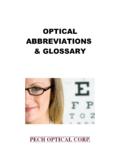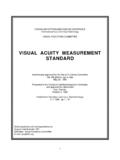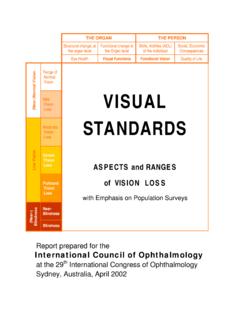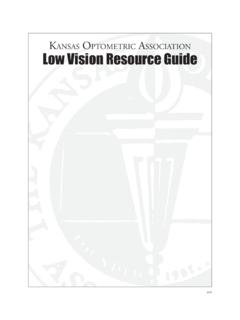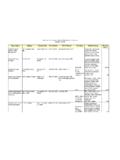Transcription of Visual acuity measurements - hicsoap.com
1 Guest editorialVisual acuity measurementshas been done incorrectly in most basicModern Visual acuity charts are designed so the lettersizes on each line follow a geometric progressionproblem relates to the difference between the arithmeticand geometric mean for a set of numbers. For the correct(ie, change in a uniform step on a logarithmic scale).1 3 The accepted step size has been chosen to be logaverage Visual acuity , the geometric mean must be used,unit, which is equivalent to letter sizes changing by awhich gives significantly different values than the arith-factor of between lines. This standard gave risemetic the logMAR (logarithm of the minimum angle ofThe simplest method for computing the proper aver-resolution) notation as shown in Table 1, column 3.
2 Theage Visual acuity from any notation is to convert the valueboldvalues correspond to the accepted logMAR the logMAR equivalent and then take the average of theValues that are not in logMAR steps such as 20/30,logMAR values. The easiest way to compute the logMAR20/60, 20/70, 20/150, and 20/300 are included becausevalue is to convert to the decimal notation and then takeof their common appearance in older Visual acuity negative of the logarithm. For example, 20/20 1andA geometric progression of lines on the Visual acuity chartthe log of 1 is 0, and 20/200 and the negativewas chosen because it parallels the way our Visual systemof the log is ; the average of 0 and If patient 1 has a Visual acuity of 20/20 andlogMAR units.
3 Converting back from the logMAR valuepatient 2 has a Visual acuity of 20/40, we conclude thatof , the corresponding Visual acuity is 20/63, thepatient 1 has two times better Visual acuity than patientcorrect geometric because he/she can recognize a letter twice as formulas for going from decimal to logMAROnce we have chosen to compare vision as a ratio usingand then back are as follows:a reference Visual angle (20/20), a geometric progressionlogMAR log (decimal acuity )(1)results and a geometric mean must be calculated for adecimal acuity antilog ( logMAR) 10 logMAR(2)meaningful that in Table 1, the only values that increaseTwo other considerations occur when sets of Visual acuitylinearly are the line numbers and the logMar are evaluated: (1) what to do with valuesSnellen acuity , decimal acuity , and Visual angle increaseof counting fingers, hand motion, light perception, etc.
4 ,by the geometric factor of Once we have decidedand (2) how to compute the correct value if the patientthat equal steps in Visual acuity measurement are geometricdid not read all the letters on the line not arithmetic, we must use the appropriate geometricmean to compute the correct Fingers, Hand Motion, Light Perception,No Light PerceptionIn Table 1, we see that line 0 is the 20/20 Snellenacuity that corresponds to the logMAR value zero, sinceCounting fingers at a given distance can be convertedto a Snellen equivalent by assuming that the fingers are20/20 is the standard. We also see that line 10 is 20/200 Snellen Visual acuity , which corresponds to a logMARapproximately the size of the elements of a 200 , a person who can count fingers at 20 feetvalue of (10 times or 1 log unit worse than 20/20).
5 Intuitively, it would appear that halfway between linewould have approximately 20/200 person ableto count fingers at 2 feet would have 2/200 vision or0 and line 10 would be line 5 or 20/63. This is thecorrect average, because geometrically it is halfwaythe equivalent of 20/2000. This value is somewhat conser-vative because a hand against a white coat is much lowerbetween 20/200 and 20 the average Visual acuity and standardcontrast than a black letter on a white background. Also,the examiner usually uses 4 or fewer fingers, making thedeviation in a series of patients is not difficult, but 2004 ASCRS and ESCRS0886-3350/04/$ see front matterPublished by Elsevier.
6 S0886-3350(03)00125-7 GUEST EDITORIALT able acuity conversion EquivalentVisualSpatial% Central% CentralRevisedLineAngle FrequencyVisualFeetMeterVisualInches CentimetersJaegerAmerican M Number(min)(Cyc/deg) LogMAR Efficiency20/6/Decimal Efficienty(14/ )(35/ )Standard Point-Type Notation * values are standard logMAR logarithm of the minimum angle of resolution*20/2000 is equivalent to counting fingers @ 2 feet 20/20000 is equivalent to hand motion @ 2 feetnumber of forced choices less than the number of Snel-Light perception with and without projection andno light perception are not actually Visual acuity mea-len optotypes (10).
7 Surements, but simply the detection of a stimulus. TheseFrom studies we have performed in our low-visioncases should be excluded and described in the materialsclinic, hand motion at a given distance is 10 times worseand methods section of the counting fingers; ie, a person who can detect handmotion at 20 feet has approximately 20/2000 SnellenPatient Cannot Read Entire Linevisual acuity equivalent. A person who has hand motionIt is very common for Visual acuity sets to includeat 2 feet would have an equivalent Snellen acuity ofvalues in which the patient did not read all of the letterson a single line correctly. Although recording the last20 CATARACT REFRACT SURG VOL 30, FEBRUARY 2004288 GUEST EDITORIALT able acuity data set for 7 theoretical VisualSnellenDecimalLogMAREyeAcuity*Equi valentEquivalentEquivalent120/1020 220/10 2 320/40 ** @ 2 ft20 ** @ 2 ft20 SD20/142 counting fingers; HM hand motion; LogMAR logarithm of the minimum angle of resolution*Bailey-Lovie Visual acuity chart with 5 letters on each lineline that was read completely or the majority of letterslogMAR values for Visual acuity .
8 Performing these analy-ses using any other value for Visual acuity will lead to(3 out of 5) is an acceptable method, it reduces theprecision of the measurement , similar to rounding offerroneous ,8 Table 2 gives a 7-patient sample data set to illustratelaboratory measurements . A more accurate method isto interpolate between the values of the logMAR acuitythe correct calculations and serves as a guide for aninvestigator to use to validate his/her calculation the fraction of the number of letters correctlyread on a Visual acuity average value and standard deviation are calculatedusing the logMAR values. The average logMAR acuityFor example, suppose our acuity chart had 5 letterson each Visual acuity line and the patient read all thewas and the standard deviation was , normallyexpressed as To determine the equivalentletters on the 20/50 (logMAR ) line but only3 of the 5 letters on the 20/40 (logMAR ) acuity for the average, we must use equationThree fifths (3/5 ) of the way from logMAR above:to is logMAR The logMAR value of Visual acuity 10 LogMAR 10 the correct value for this patient s Visual acuity .
9 ForSnellen Visual acuity Denominator 20/Decimal Acuitystudies that involve large data bases, in which converting 20 142the values manually is tedious, we have published theformulas that allow direct conversion from the SnellenSnellen Visual acuity 20/142acuity value to the interpolated logMAR only meaningful conversion of the standard de-formulas work only if there are an equal number ofviation in logMAR units is to lines of Visual on a line, such as the Bailey-Lovie Visual acuitySince each line of the standardized Visual acuity chartchart3and other standardized by log units, a standard deviation of , if the number of letters on the acuitylog units is equivalent to lines ( ).
10 Inchart are not equal on each line (as occurs on manythis data set of 7 patients, the mean Visual acuity andprojector and wall charts), a table must be created thatstandard deviation are logMAR units,shows the conversion interpolation for each line and lines in decimal units, and 20/142 single formula is not lines in Snellen statistical calculations such as correlation coef-Sample Calculationsficients, Studentttest, analysis of variance should beOnce the logMAR value for the Visual acuity ofperformed using the logMAR values, as shown aboveeach patient has been obtained, statistical analyses onfor the mean and standard deviation.


